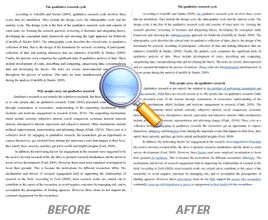
Lesson 19: Editing & Trimming
In this lesson we’ll discuss how to edit your thesis to make sure that it’s cohesive.
Objectives:
- To discuss how to edit a finished thesis paper
- To discuss how editing and trimming relate to one another
- To establish the importance of submitting a cohesive paper
Quick Navigation through the Lesson 19:
- Review your headings
- Review your sub-headings
- Review the structure of your paper
- Check for inconsistencies in Tone and Point of View
- Don’t be afraid to trim
In this lesson, we’ll be talking about the different tricks and tips which you can use when editing your paper. Before we begin, it’s important for us to see how the two processes relate to each other—how are they different and why are they discussed together?
 Editing pertains to the general process of curating written information. When we edit something, we decide what information to keep, alter or remove altogether. Trimming refers to the act of removing bits of text from a body of work in order to improve it. Trimming is a consequence of editing. This is why this section of our lesson is entitled editing even if it has two lessons under it.
Editing pertains to the general process of curating written information. When we edit something, we decide what information to keep, alter or remove altogether. Trimming refers to the act of removing bits of text from a body of work in order to improve it. Trimming is a consequence of editing. This is why this section of our lesson is entitled editing even if it has two lessons under it.
These two processes are extremely important before you finish your thesis. Even if your thesis is informative, if it contains too much information or if it contains certain details which aren’t cohesive, your panelists and future readers will find it confusing and difficult to understand. This could lead to a misinterpretation of your data or worse, a failing mark for your paper based on the deficiencies in organization.
Below are a couple of tips to help you out:
Review your headings.
This is important because your headings determine what a certain chunk of information is about. Review your headings and their subsequent text and ask yourself whether the text properly relates to the headings. Is the text informative? Is there anything that you’ve left out? Or is there anything you mentioned which doesn’t belong in this category?
Review your sub-headings.
Reviewing your subheadings helps you take a closer look at the paper’s flow of ideas. Ask yourself how the subheading relates to the main heading. Why did you include it here? Could it do better in the other sections? What is its relationship with the other subheadings? Furthermore, review the text under your subheadings and check if there are any ideas which don’t belong there.
[WpProQuiz 187]
Review the structure of your paper.
 Take a look at the structure of your paper—ask yourself why it’s organized that way? Is it logical? Is this the best way for you to communicate the findings of your study to your reader? Try to experiment by inverting the order of certain paragraphs or sentences. This is especially useful for your review of related literature: see if things can be organized better until you’re satisfied or convinced that the order you’ve chosen is the best one.
Take a look at the structure of your paper—ask yourself why it’s organized that way? Is it logical? Is this the best way for you to communicate the findings of your study to your reader? Try to experiment by inverting the order of certain paragraphs or sentences. This is especially useful for your review of related literature: see if things can be organized better until you’re satisfied or convinced that the order you’ve chosen is the best one.
Check for inconsistencies in Tone and Point of View.
Tone is determined by the conventions of your field of study and it can be very different to get used to if this is your first time writing a thesis paper. Point of View also depends on which part of the thesis you’re writing (e.g. results employ a 3rd person POV, always). Because of the switching back-and-forth between POVs and the formality of tone in academic papers, it’s likely that you may have written some things inconsistently, slipping out of the tone of voice. This disrupts the flow of your ideas and makes the information more difficult to follow. Double-check and make changes where you need to.
Don’t be afraid to trim.
A longer thesis isn’t always better—unless, of course there’s a page requirement which you need to fulfill—don’t be afraid to cut out sentences or paragraphs which are unnecessary. Trimming the excess parts of your thesis will help you shape it so that your readers and panelists can better see the picture you’re trying to present to them.
[WpProQuiz 188]
In this lesson we were able to learn about editing and trimming and how they go hand-in-hand. We were also able to talk about why cohesiveness is such a big part of writing a good thesis. In addition to this, we were also able to enumerate different guidelines we can follow to make editing our thesis easier.
Next we’ll be talking about proofreading our thesis. We’ll look at why this is important and how it differs from what we took up in this lesson.

 + 1-888-827-0150
+ 1-888-827-0150 + 44-20-3006-2750
+ 44-20-3006-2750









